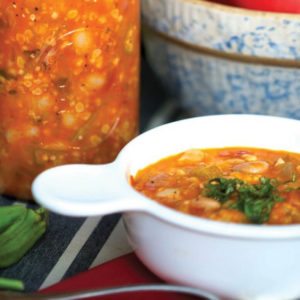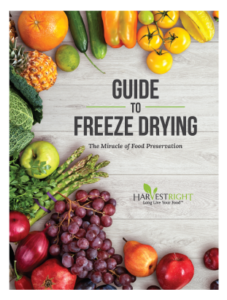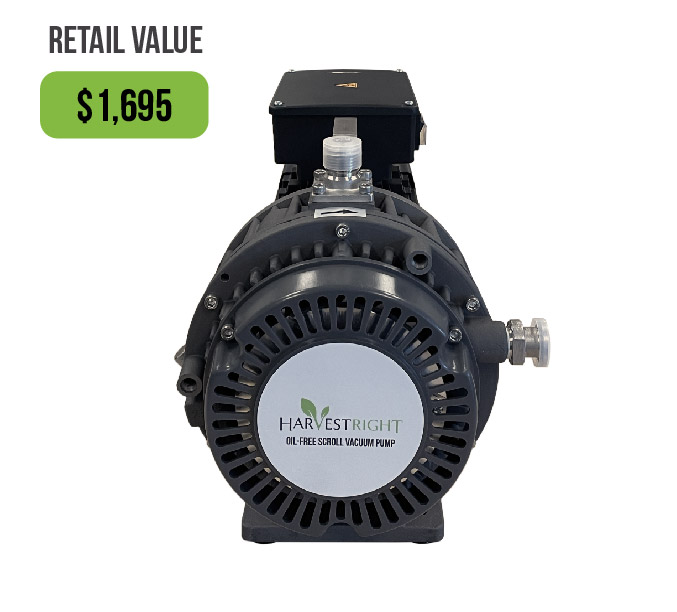
We’ve still got a few more weeks of soup weather before we can switch to Spring salads. While you’re making winter soups, you may want to consider making an extra batch to start, or add to, an emergency food supply. Soup is comforting, and re-hydrating it with hot water brings it right back to its original flavor and consistency. When freeze dried, it’s light and compact – perfect for camping meals, too.
Root vegetables are still plentiful at the grocery store, and pretty soon you may even find them on sale as produce bins start to give way to other seasonal vegetables. Snap up any bargains you find and get your soup stash made for next winter. We’ve been experimenting with hearty soups all winter. We’ve learned that you really can make a delicious soup out of almost any leftover vegetable or meat entree. Start with a good vegetable or chicken stock (or bouillon cubes in a pinch), and add diced vegetables and small-bite pasta or rice. If you have leftover chicken breast, steak, or meatballs, just pop them in to simmer.
To freeze dry soup, pour cooked soup on the freeze drying trays and process. Break the freeze dried soup into small chunks and store in an airtight container until you’re ready to use. Stored properly, freeze dried food will last up to 25 years, so homemade soup is a great staple for your emergency food supply.
To re-hydrate soup, just add hot water until it returns to it’s original consistency.
Here’s one of our favorite soup recipes to get you through the last bit of winter. This version is vegan, but you can add cream and / or cooked chicken if you like:
Dairy-free Corn Chowder
- 1 bag frozen corn
- 2 large potatoes in 1″ dice
- 3 tablespoon olive oil
- 1 large sweet onion
- 4 cloves garlic
- 3 carrots, peeled and chopped
- 3 stalks celery, washed and chopped
- 1 red bell pepper, cored and diced
- 2 teaspoons salt
- 1 teaspoon fresh ground pepper
- 1 teaspoon oregano
- 4 cups vegetable broth (or chicken stock)
Put the potatoes in a pot of boiling water and let them boil until soft. In a stock pot, saute’ onion and garlic in olive oil until translucent. Reduce to medium heat and add vegetable or chicken stock, corn, carrots, celery, bell pepper, salt, pepper and oregano. While the vegetables simmer, drain cooked potatoes and transfer to a blender or food process. Blend until smooth. Begin to add potato puree to the soup until it’s thickened. If you want a traditionally creamier soup, leave the potatoes in a 1″ dice and add to soup with the vegetables. Add 1/2 cup of heavy cream to make the soup a traditional chowder.





Question:
Can you successfully freeze dry a soup with both meat & veg. ??
I’ve a batch of smoked ham & white bean soup, which prompted this question..
Second Question ;
Can you freeze dry a steak that’s been
A) Marked on the grill..
Which I’m sure is yes…
B) Marked, then Sous Vides ??
Yes, it is definitely possible. I’ve seen where some people do it separately. Mainly because of rehydration time required for the different vegetables/meats. (For example, veggies might rehydrate quickly, while some meats may take a little longer. Meaning, you don’t want your veggies to get too soft while waiting for the meat to rehydrate. Beans and ham specifically should work just fine.)
The answer to your other questions is ‘yes!’ 🙂
How long does the soup take to freeze dry because of all the liquid?
I did my first all wet experiment last week. I beat eggs and freeze dried them. They were totally liquid. It took a couple of days to freeze dry, but it did work. And with the cost of eggs skyrocketing, it is gratifying to know this works.
Tomorrow I will do broccoli cheddar soup…
ONE THING TO CONSIDER: the freeze drier is higher in the front of the machine and lower in the back, in order to defrost/drain. Because of this slant, the liquid slides to the rear of the pan and slops over the sides. I placed a piece of metal under the tray holder to try to level it out so the product will dry evenly and not spill.
We prefreeze eggs and soups the night before so the slant has no effect in the dryer also saves drying time … we run almost 24/7 and have invested in two addition set of try’s so we are always ready for the next batch in the freezer
If you out the trays in the freezer first (to freeze what you are processing), it doesn’t take as long to freeze dry.
I have some samples of the HarvestRight broccoli cheddar soup. How do I rehydrate/cook it?
The best way to rehydrate is by slowly adding hot water until it is the desired consistency.
If a soup has heavy cream in it, will it freeze dry ok?
Did you get an answer to this question? I am wanting to freeze dry chicken tortilla soup but it has half and half. Don’t know if this would make it to watered down when reconstituting. Have not seen anyone answer your question.
According to Harvest Right, soup with heavy cream can freeze dry.
Instead of freeze drying soup with all the liquid, could I freeze dry the veggies, meat, then add regular dried seasonings and granulated broth- seal in Mylar bags. Then you just add the hot water when ready to eat?
Would I need to freeze dry the seasonings and bullion too?
We keep reading that we should pre freeze soups so that you don’t end up with a mess to clean up. Harvest Right makes no mention of this. Is it important to pre freeze soups before processing in freeze dryer and why would there be a mess if we did not pre freeze? Thank you
In general it is a good idea to pre-freeze liquids. However, with the latest software there is not a need. There won’t be a mess.
I mentioned in earlier reply that the rear of machine is lower than the front ( by design for defrosting/draining) So when putting liquids in, the volume on the freezing sheet does not stay level. It will run toward the rear and spill over. I think freezing is a good idea so that doesn’t happen.
Lots of good info on the web on these topics. Just remember
1. FAT is not your friend when freeze drying. LEAN meats like turkey and chicken breasts. Don’t just think you can freeze dry a t-bone and store for 25 years. Big mistake. Sirloin would be my choice for beef.
2. The idea of drying ingredients makes sense for variety. You can meal plan in the moment and add variety. I do all my meats alone in 1lb portions as well as veggies. I can then rehydrate separately if needed or toss it all in a pot with water and FD seasonings. Just a thought, I do some pre-made meals as well.
3. Pre-freezing is a must when going production. It speeds the process. Buy extra trays.
Do you set to custom mode if you freeze before freeze drying?
RE: freezing meat:
Considering many are freeze drying in case of a major disruption in society, consider a time where we may not have power. I cook all my meats before freeze drying, so they can be eaten right out of the bag or reconstituted without need of gas or electric. I tasted some reconstituted chicken recently, and we could not tell the difference between fresh and frozen!
I freeze chicken, ham, and roast beef after removing fats.
I made homemade split pea and ham soup as well as navy being in hand soup. I froze it in the freezer first and then put it in my medium freeze dryer. Just because the freeze dryer says it is done do I need to add more time.? How do I know when it is 100% freeze dried and ready for packaging in the mylar bags
I’m new to this please what is the temperature to freeze hamburger soup
How do I prepare it once its cooked?
To get technical, if you weigh your soup on the tray before you freeze dry it, then you will know what amount of water was removed when you weight it after. Then just divide that amount by the amount of servings you want to make out of the tray.
To do it without getting technical, you can just add hot water a bit at a time until you get the desired consistency you want.
As for freezing, you just place the tray with your hamburger soup into your freezer or deep freeze (either temp should suffice) until frozen solid, then proceed to the freeze drying step.
Moisture testers with and without the pins are very handy to let you instantly know if product is dry enough to package and done freeze drying. Makes turn around in production much faster. And gives peace of mind when doing new items if you don’t really know how dry it is.
What kind of moisture meter do you buy? There seems to be ones for wood and ones for plants. Are the ones with pins better?
to save on mess & already have it in portion sizes, can you freeze dry soup in silicone molds, then just pop it out to package
What happens to cornflour used in the soup as an ingredient? Does it freeze dry well? I’m trying to make a sweet corn soup for freeze drying but worried about the cornflour that I need to add in the soup for thickening it. Please advice. Thanks.